Looking at Prehistory:
Indiana's Hoosier National Forest Region, 12,000 B.C. to 1650
|

|
Looking at Prehistory:
Mississippian Period A.D. 1,000 to 1650
Temple mound sites of the Mississippian period are
scattered along the major rivers in the Midwest and southeastern United
States (Figure 96). These were very large towns with platform mounds and
plazas for gathering large crowds and places where many families lived
and farmed. These were chiefdoms in organization with social
stratification (e.g. various classes
of people including households of specialized
craftsmen and farmers, etc.) and they were centers of high religious and
soci-political importance. The sites were surrounded by palisades for
defense against raids from other groups and probably for monitoring
special agricultural fields and other reasons (Figure 97). Major towns
were connected through trade along the river
highways by canoe, as well as by overland routes.
Mississippian cultures were dependent on intensive agricultural
production and they concentrated on the cultivation of corn, beans and
squash. Small family farms and camps were scattered over the
countryside that supplied a surplus of produce, collected foods, meat
and hides to the larger towns (Figure 98).

|
|
Figure 96: A topographic contour map of Angel Mounds State Historic
Site showing the platform mounds and other prehistoric and natural
features across this large Mississippian town. A linear elevation that
runs to one of mounds (center of the picture) is the remains of a
stockade that may have been constructed late in the occupation. If so,
the Angel population may have been smaller at that time. This and many
other questions remain to be answered about the growth and demise of
this prehistoric town (Modified from Black 1967: Fig. 14).
|

|
|
Figure 97: A reconstruction of the stockade that once surrounded the
Angel site.
|
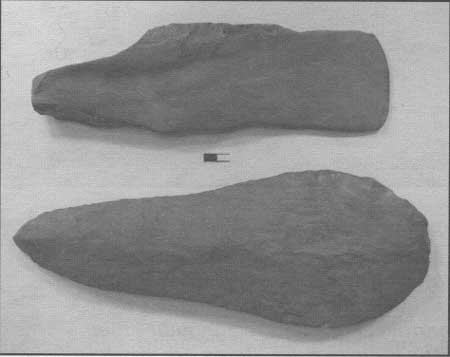
|
|
Figure 98: Mississippian hoes. Below is one made of Dover chert traded
from quarries in Tennessee. The other is from Rockhouse Hollow Shelter.
It was probably used for digging pits and roots while away from a
farming camp.
|
Mississippian houses were basically square-shaped,
with walls of upright posts set in trenches and then woven with sticks
and vines and plastered with mud. The roofs were made of grass thatch
(Figure 99). We know these architectural details because frequent fires
preserved evidence in the form of charred stains and building materials
for archaeologists to record and then reconstruct how the Angel people
built their homes. This burning was probably periodic to eliminate bugs
and other pests. Other times it was probably the result of raids by
other Indian groups and from lightning as well as household catastrophes.
Excavations at Angel Mounds have revealed the locations of numerous
houses that were established close to one another within the walls of
the town. These are marked by charred rectangular stains found below the
ground surface with concentrations of charred fragments of logs, and the
preserved impressions of thatch and especially mud or "daub" that was
used as plaster on the walls (Figure 100). Some of this evidence comes
in the form of unusual objects found in excavations such as dirt-dauber
(wasp) nests that were attached to roofing material and fired when the
houses burned. Daub that was composed mainly of clay was also
fire-hardened, preserving the impressions of cane and other plant
material woven between the upright logs (e.g. wattle) on the walls of
the homes (Figure 101).
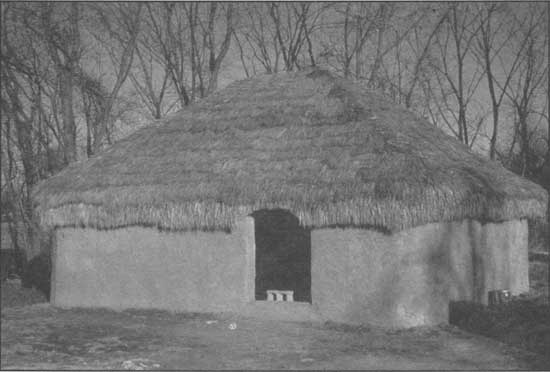
|
|
Figure 99: A reconstructed Mississippian house at Angel Mounds.
|

|
|
Figure 100: An on going excavation of a Mississippian house and
surrounding area. The house trenches that once held upright posts are
marked by the parallel lines and rectangular stain. The large circular
stains are pits filled with organic soils from repeated use for
roasting, cooking and storage below the floor of the house. Some of the
medium-sized stains mark smaller pits and also post-molds where support
posts for the roof were located. Indiana University field school,
1976.
|

|
|
Figure 101: Prehistoric wall plaster "daub" of fired clay that show the
impressions of split cane, reeds and other plant fiber used as
construction material between the support posts before the walls were
plastered with mud. The smaller pieces on the upper left are dirt-dauber
nests with fiber and grass thatch impressions. Had the homes at Angel
Mounds not been burned, such building materials would not have survived
the centuries.
|
Angel Mounds is the largest Mississippian
archaeological site in Indiana and is the most easterly of the large
Mississippian towns that were established up the Ohio River between
about A.D. 1000 and 1500 (see Figure 96). The main population of the
Angel phase may have descended from the earlier
Yankeetown phase people who showed a number of traits that later
manifest in the Angel phase. Mississippian villages and towns are often
rich in material culture (Figures 102-103). Salt licks were
frequented by Mississippian peoples, where they made
and left behind many fragments of large ceramic pans (Figure 104) that
were employed to evaporate the water and collect salt crystals for a
variety of uses in cooking, as well as for preserving meat and animal
hides for storage and trade.

|
|
Figure 102: Some variations of shell-tempered Mississippian ceramics
including "negative painted" sherds from Angel Mounds. The paint was
applied as a wash over the area decorated with some kind of resist.
|

|
|
Figure 103: Various Mississippian artifacts from Angel Mounds, including
pottery disks, fish hooks, a broken bone "beamer", a "labret" for lip or
ear decoration, and other artifacts. There is also a chipped chisel with
a carefully honed bit for wood working, such as house and wall
construction and making dug-out canoes, etc.
|
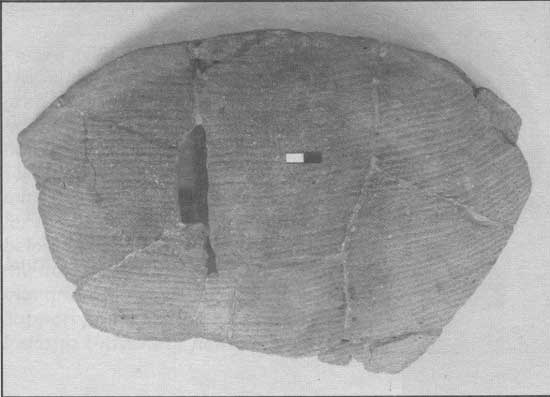
|
|
Figure 104: A partial reconstruction of a large Mississippian
salt-pan. It is shown from the back to reveal the impression of a fabric
employed in the manufacture of the pan.
|
Two Mississippian phases appear to be sequential
occupations in southwestern Indiana. These include the Angel and
Caborn-Welborn phases. Probably unrelated to these
is the Vincennes phase located further to the
north and west, and the Fort Ancient tradition of southern Ohio that
clearly borrowed or adopted shell tempering for ceramics and a number of
other practices, but remained committed to their own culture--including
leadership and political control. The Falls of the Ohio area also has a
Mississippian settlement that is poorly known, although it too was
probably a separate political unit at this time.
Caborn-Welborn, with its distinctive decorated
ceramics, comes after the Angel phase and dates from about A.D. 1400 to
1700 (Figure 105). It apparently lacked mound centers and had small
dispersed settlements centered around the confluence of the Ohio and
Wabash Rivers, as there are few identified sites outside of the
immediate vicinity of the river valleys. Their territory apparently did
not reach east into the Hoosier National Forest region to any
extent.

|
|
Figure 105: Caborn-Welborn phase decorated ceramics, end-scrapers, and
a fine chisel for working wood from Hovey Lake and other sites.
|
Angel phase settlements required larger territories
while still maintaining a close connection to the major rivers. Rockhouse Hollow
Shelter was used by Angel phase people who left ample
evidence of their presence in many undecorated shell-tempered
pot-sherds deposited within the upper midden of the site (Figure
106). While these people were connected to an
elaborate and sophisticated culture, there are few
signs they did anything overly different from the Late Woodland peoples
who lived in this and other rockshelters in the hill country. These
occupations probably represent fall base camps where hunting expeditions
were staged to obtain the meat and hides of deer and other animals to
supply the large Angel town located about sixty miles down river. When
not engaged in hunting and collecting in the hill country, these people
probably lived at or near Angel site and participated in the building
and maintenance of houses, stockades, mounds and attended many
ceremonies held at that large town (Figure 107).
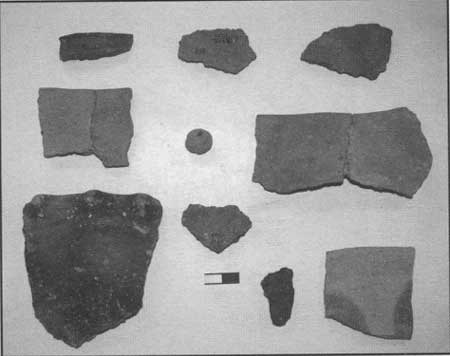
|
|
Figure 106: Mississippian ceramic rim and body fragments (sherds) and
a fired clay bead from Angel Mounds and Rockhouse Hollow Shelter.
|

|
|
Figure 107: The famous figurine from Angel Mounds sculpted from a large
fluorite crystal. The Mississippian people placed this figure within the upper levels of
Mound F at the site. Perhaps this represents the final ceremonial event in the
use of the mound.
|
Early historic records indicate the eastern or
"woods" bison made an annual migration across the Hoosier National
Forest south of Patoka Lake, between prairies at Vincennes and further
west into Illinois and the prairies and salt licks around Big Bone Lick,
Kentucky (Figure 108). While this species of bison was exterminated
shortly after the arrival of Euroamericans to the area, the bison wore a
path across southern Indiana that can still be seen in some places today
(Figure 109). This buffalo trace was so substantial at the turn of the
century that it became a ready avenue for the first
settlers to drive livestock and carry the wagons
full of belongings into south-central Indiana.
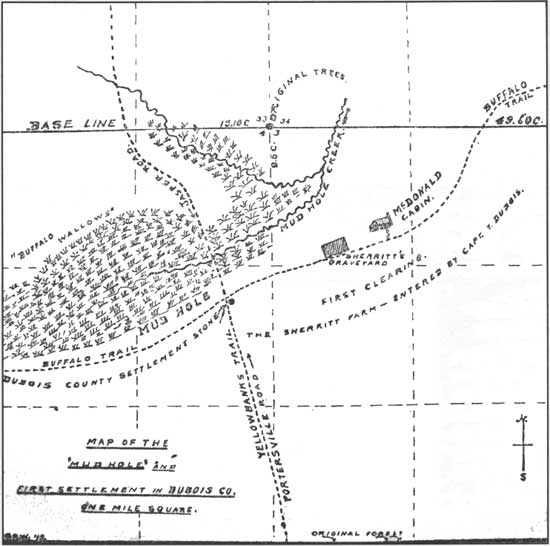
|
|
Figure 108: The Buffalo Trace and a mud hole "wallow" as it was
mapped and described in the original land survey of Dubois County, IN.
Eastern bison bones were occasionally found in the marshes nearby (from
Wilson 1919: Plate 5).
|

|
|
Figure 109: A view of a surviving section of the
Buffalo Trace, now heavily forested.
Countless animals, prehistoric people, soldiers, American settlers, and
travelers passed through southern Indiana using this natural road
through the wilderness.
|
Historical records suggest bison were numerous, but
their remains are very scarce. Only two archaeological sites with more
than a few skeletal elements reported as bison have been documented.
These are located near Rockport in Spencer County and their association
is with 18th century Euroamerican campsites established on the river
bank. There are only a few scattered elements of bison bone identified
from Mississippian period Caborn-Welborn phase sites in southwestern
Indiana and others in Kentucky. There are also a few bones identified as
bison from Oliver phase sites and some of them were modified into tools
(Figure 110). So far, we have no evidence of prehistoric bison kill
sites in Indiana or the surrounding region. Dried meat, hides and bones
for tools could have been readily traded far from sites where bison were
killed and butchered. A major problem is that the skeletons of modern
cattle, oxen, and bison are difficult to distinguish without skulls and
other key elements. In addition, when skeletons are incomplete and
fragmentary, the individual bones of elk and other large game can be
also confused with bison.

|
|
Figure 110: A hoe possibly made from a bison
scapula (shoulder blade) from the Bowen site, an Oliver phase village in
central Indiana. It is heavily worn from use on the broad end. A bony
ridge has been mostly chipped away to tie (haft) the blade to a
handle.
|
We do not know why bison began regularly crossing
south-central Indiana, nor do we know when this change in migration
pattern first began. The Falls of Ohio was a crossing for migrating
bison and humans, as well as a portage and destination for prehistoric
river travelers back thousands of years. Part of the bison trace does
cross the "barrens" of Harrison County that was largely treeless when
the pioneers first came to the region. Grasslands near and along the
trace are also documented by the original land surveyors north of New
Albany in Clark County. These and other patches of grassland apparently
persisted throughout prehistory and may have been first maintained by
the feeding habits and movements of mammoths, mastodons, and possibly
prehistoric man that, much later, became an attractive grazing avenue
and trace for the annual migrations of bison.
Bison remains from the Rockport sites and others from
historic and late prehistoric sites should be included in a
larger study to clarify the
identification of bison remains and the archaeological evidence for
prehistoric utilization of bison in the Midwest. Such a research project
should include archaeological surveys in the vicinity of Buffalo Trace
features, attempt to reconstruct the natural history and migration
patterns of bison east of the Mississippi River, and also address late
prehistoric aboriginal food preferences and hunting practices in Indiana
and surrounding states with regard to bison.
9/hoosier/prehistory/sec8.htm
Last Updated: 21-Nov-2008 |
|















